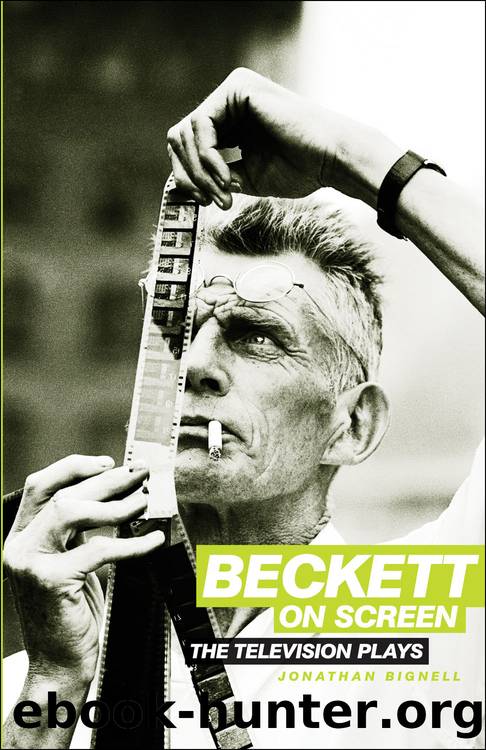Beckett on Screen by Jonathan Bignell;

Author:Jonathan Bignell;
Language: eng
Format: epub
Publisher: Manchester University Press
Published: 2009-11-15T00:00:00+00:00
Posthumous reverence
The iconic role of photographs of Beckett has already been discussed (Voigts-Virchow, 2000â1) and has been a persistent feature of television broadcasts of Beckettâs work and in documentary features about him, as in the photographic montages in the introductory commentary by Melvyn Bragg and Martin Esslin in The Lively Arts: Shades, and in the BBCâs tribute documentaries Beckett at 80 (1986) and A Wake for Sam (1990). Most recently, the presentation box and booklet supplied with the Beckett on Film productions on DVD are notable for their many images of Beckett. The iconic status of Beckett, signified in part by these pictures, raises interesting paradoxes in relation to the Beckett on Film productions as regards the relative significance of author, directors and production institutions.
Channel 4âs investment in the Beckett season is to some extent consistent with the channelâs original remit yet marks an interesting difference from the terms of its foundation in the early 1980s (Greenhalgh, 1998). Channel 4 was devised with a large and guaranteed income provided by the advertising revenues of ITV companies, yet with an injunction from government not to pursue the large audiences that gained ITV that money but, in contrast, to be distinctively different from mainstream television, to be innovative, to provide programmes for minorities and to articulate the concerns of those whose interests were rarely represented on television. This set-up was clearly based on the post-war consensus that had established Public Service Broadcasting throughout the twentieth century, and it represented an enterprising yet troubled yoking together of commercial funding and the values of subsidised public service. There are several ways to regard the position of Channel 4 in the broadcasting landscape. First, it can be regarded as a strategy of repressive tolerance, in which marginal and potentially radical broadcasting can be contained yet expressed without posing a threat to the established duopoly of BBC and ITV. Second, it can be regarded as a safe haven for television producers and creators whose work is amenable neither to the broad middlebrow audiences sought increasingly by a BBC anxious to defend its licence fee by drawing audiences of substantial size, nor to an ITV increasingly threatened in its address to downmarket mass audiences. These threats consist of audience fragmentation created by a multichannel environment, advertisersâ increasing interest in valuable niche markets and decreasing interest in masses, and an audience profile of increasing age and diminishing income. Third, the fact that Channel 4 is a publisher broadcaster rather than a programme maker means that it is able to respond quickly to the rapidly changing fortunes of the television industry, as an enterprise business driven by market forces. These three very different ways of understanding the cultural role of Channel 4 fit in different ways into the seemingly hesitant and unplanned attitude of the channel to the Beckett season.
Michael Kustow, the first Commissioning Editor for the Arts on Channel 4, came to the channel from the National Theatre, and before that from a post as Director of the Institute of Contemporary Arts.
Download
This site does not store any files on its server. We only index and link to content provided by other sites. Please contact the content providers to delete copyright contents if any and email us, we'll remove relevant links or contents immediately.
Kathy Andrews Collection by Kathy Andrews(11709)
The remains of the day by Kazuo Ishiguro(8791)
Paper Towns by Green John(5065)
Spare by Prince Harry The Duke of Sussex(5054)
The Body: A Guide for Occupants by Bill Bryson(4954)
Industrial Automation from Scratch: A hands-on guide to using sensors, actuators, PLCs, HMIs, and SCADA to automate industrial processes by Olushola Akande(4920)
Machine Learning at Scale with H2O by Gregory Keys | David Whiting(4115)
Be in a Treehouse by Pete Nelson(3924)
Never by Ken Follett(3767)
Harry Potter and the Goblet Of Fire by J.K. Rowling(3759)
Goodbye Paradise(3714)
Into Thin Air by Jon Krakauer(3290)
The Remains of the Day by Kazuo Ishiguro(3280)
The Cellar by Natasha Preston(3242)
The Genius of Japanese Carpentry by Azby Brown(3209)
Fairy Tale by Stephen King(3197)
120 Days of Sodom by Marquis de Sade(3161)
The Man Who Died Twice by Richard Osman(2981)
Drawing Shortcuts: Developing Quick Drawing Skills Using Today's Technology by Leggitt Jim(2975)
